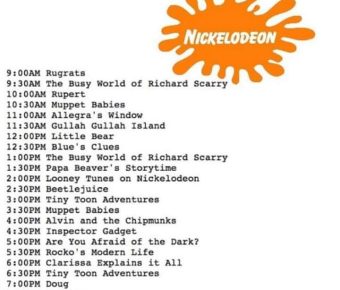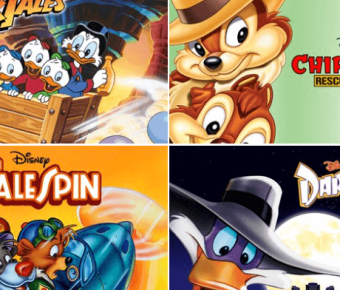
Nickelodeon: Then and Now
Nickelodeon: Then and Now
Growing up in the ’90s and early 2000s, Nickelodeon was a cultural cornerstone. Its programming carved a niche that was rivaled only by Cartoon Network and the Disney Channel, yet Nickelodeon reigned supreme for many kids and teens. The network’s wide variety of shows, colorful and wacky personality, and unforgettable characters made it a defining part of childhood.
From slime-filled game shows to groundbreaking cartoons, Nickelodeon offered something unique for every kid. It was more than a TV network—it was a part of growing up.
Variety: Nickelodeon’s Nostalgic Era for ’90s Kids (1990–2002)
During Nickelodeon’s golden era, the network stood out for its incredible variety of programming. It offered content that appealed to a wide range of interests, blending creativity with humor and a touch of absurdity. This era gave us:
1. Animated Classics
Nickelodeon was home to some of the most memorable cartoons of all time, each with its own unique style and characters:
- Rugrats: Created by Arlene Klasky, Gábor Csupó, and Paul Germain, this show brought the world to life through the eyes of adventurous babies, mixing humor with heartfelt moments.
- Hey Arnold!: The adventures of a football-headed boy and his friends in the city balanced quirky humor with surprising depth.
- Aaahh! Real Monsters: A creepy, imaginative look at the lives of monsters learning to scare humans.
- SpongeBob SquarePants: Created by Stephen Hillenburg, this underwater comedy premiered in 1999 and became a global phenomenon, continuing to captivate audiences today.
2. Sketch Comedy Shows
Nickelodeon made sketch comedy accessible and hilarious for kids. Shows like All That, The Amanda Show, and KaBlam! were packed with skits, recurring characters, and plenty of laughs:
- All That: Known as the kids’ version of Saturday Night Live, it featured iconic cast members like Kenan Thompson and Amanda Bynes.
- The Amanda Show: A spin-off for Amanda Bynes that combined absurd sketches with unforgettable characters like Judge Trudy.
3. Live-Action Sitcoms
Nickelodeon also delivered standout sitcoms:
- Kenan & Kel: This hilarious show about two best friends is still beloved, with Kel Mitchell’s “Who loves orange soda?” becoming an iconic catchphrase.
- The Naked Brothers Band: A mockumentary-style series about a fictional kids’ rock band, blending music and comedy.
4. Reality Competitions
Nickelodeon’s game shows were unlike anything else on TV, featuring physical challenges, puzzles, and, of course, slime:
- Double Dare: The game show that turned getting messy into an art form.
- Legends of the Hidden Temple: A mix of trivia and obstacle courses with a jungle adventure vibe.
- GUTS: A competition show where kids tested their athletic abilities on intense challenges.
- Figure It Out: A panel of Nickelodeon stars tried to guess contestants’ hidden talents or secrets, often ending in slime.
Nickelodeon Today: A New Era
While Nickelodeon still offers a variety of programming, the network has undeniably changed. Its current slate includes animated hits like The Loud House and PAW Patrol, as well as live-action shows like Henry Danger and its spin-off Danger Force. Yet, many feel it lacks the charm and creativity of its earlier years.
One of the most noticeable differences is the absence of sketch comedy, which was a staple of Nickelodeon’s golden era. Shows like All That were recently revived but haven’t quite captured the same cultural impact. However, SpongeBob SquarePants remains a cornerstone of the network, bridging the gap between generations.
Nickelodeon has also embraced streaming platforms like Paramount+, ensuring its content reaches today’s tech-savvy kids. But for those of us who grew up with the classics, it’s hard not to feel that something is missing—a certain sense of whimsy and originality that made Nickelodeon’s earlier years so magical.
Generational Differences: Then vs. Now
The differences between Nickelodeon’s golden era and today’s programming can be attributed to generational shifts. The kids of the ’90s grew up during a transitional time—before smartphones and streaming platforms dominated daily life. We balanced outdoor play with video games and Saturday morning cartoons. Nickelodeon reflected this mix of analog and digital childhood experiences, offering programming that felt inventive and fresh.
In contrast, today’s generation has grown up in a digital-first world. Smartphones, social media, and streaming platforms like YouTube are central to their lives. Nickelodeon has adapted to this shift, creating content that resonates with its current audience, but the changes can make it feel unfamiliar to those of us who remember its earlier years.
The Nickelodeon Experience: Slime and Block Parties
Nickelodeon wasn’t just a network; it was an experience. Beyond the shows, it created immersive events like:
- The Nickelodeon Kids’ Choice Awards: The annual awards show where kids got to vote for their favorites—and see celebrities get slimed.
- Nick in the Afternoon: A block of shows hosted by the quirky stick figure character Stick Stickly, complete with his memorable jingle: “Write to me, Stick Stickly, P.O. Box 963, New York City, New York State, 10108.”
These moments made Nickelodeon feel interactive, fostering a sense of community among its viewers.
Nickelodeon’s Legacy
Despite its evolution, Nickelodeon remains one of the top kids’ networks, continuing to entertain new generations. Its legacy lies not only in the shows it created but in the memories it gave to millions of kids who grew up watching. For those of us from the ’90s, Nickelodeon will always represent a simpler, more creative time in television.
Looking Forward: Quiet on Set
As we reflect on Nickelodeon’s golden years, it’s exciting to see projects like Quiet on Set, which delve into the behind-the-scenes stories of iconic shows. By exploring the creativity and hard work that brought these programs to life, Quiet on Set gives fans a chance to reconnect with the magic of the shows that shaped their childhoods. It’s a reminder of Nickelodeon’s enduring impact on pop culture and its ability to inspire joy across generations.


